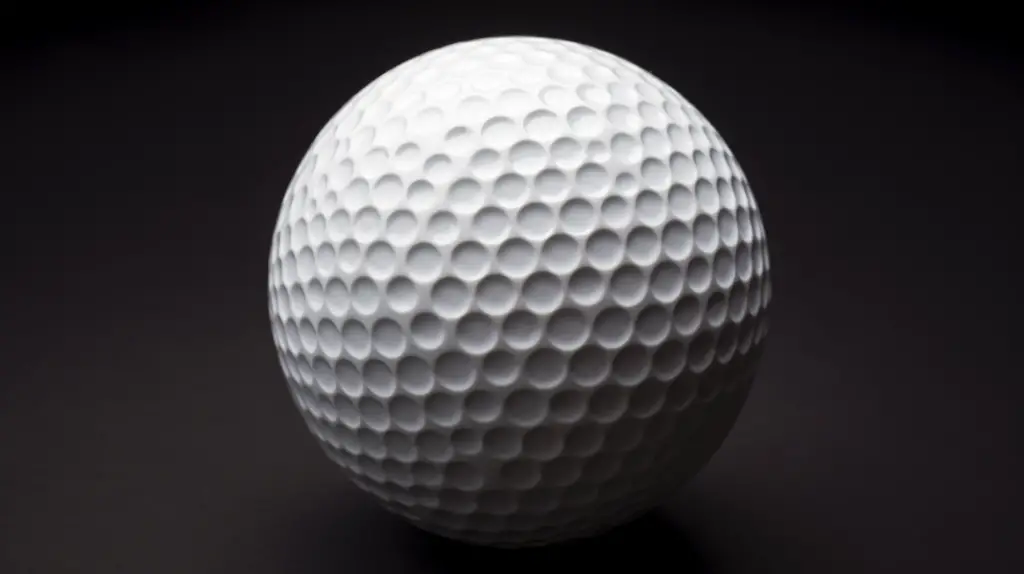Last Updated on November 21, 2023
The golf ball has been around for centuries, but how big is it? That’s the question we’ll answer in this article. Every golfer knows that the size of a golf ball affects its flight and trajectory, so it’s important to know exactly how big one actually is. We’ll take an in-depth look at what makes up a golf ball and why understanding its size is key for success on the course.
Ever since the first golf balls were made from wood or leather stuffed with feathers, people have been looking to improve upon their design. As technology advanced, manufacturers began experimenting with different materials and shapes to provide better performance in distance and accuracy. But no matter what type of material was used, all modern-day golf balls are about 1.68 inches (42mm) in diameter – pretty small when you think about it.
So now that we know the general dimensions of a standard golf ball, let’s dive into some more specifics, such as weight and construction materials. We’ll also discuss how these factors can influence your game and help make sure each shot lands where you want it to go.
Physical Structure Of A Golf Ball
Golf balls have a unique physical structure that is specifically designed to optimize their performance. They generally consist of three layers, with the innermost layer composed of a solid rubber or resin core and an outer shell made up of two separate pieces. The ball construction materials are typically highly durable synthetic polymers such as Surlyn and urethane. These materials enable golf balls to preserve their sphere shape during flight while also providing optimal compression on impact for maximum energy transfer from the club face to the ball.
The dimple design on the surface of a golf ball has been found to be critical in determining its aerodynamic properties; this helps reduce drag and increase lift, allowing it to travel further distances through the air. On average, a regulation golf ball measures 1.68 inches (4.26 cm) in diameter and weighs about 1.62 ounces (45.93 g).
Standardization And Regulation Of Golf Balls
The standardization and regulation of golf balls is an integral part of the game. This ensures fair playability for all players. In order to do this, the USGA has created a set of specifications that describe the size and physical characteristics of a golf ball. The overall diameter must be between 1.68 and 1.72 inches (42.67 to 43.67 mm). Weight should range between 45 and 50 grams, while hardness can vary from 40-90 compression points on a Durometer scale. Additionally, dimple patterns must consist of at least 332 indentations in total across the surface area, with no single dimple having more than 25% coverage in any one area.
These rules have been put into place by organizations such as the USGA and R&A in order to ensure fairness during competition or recreational play alike. As long as a golf ball meets these criteria, it can be used in competitive tournaments throughout the world without issue – providing everyone with an equal playing field regardless of their equipment or skill level.
Dimensions And Weight Of A Golf Ball

Golf balls are small, spherical objects that come in various shapes and sizes. They have a diameter of 1.68 inches (4.27 cm) and typically weigh around 45 grams. The size of the golf ball is determined by its circumference, which ranges from 42 to 43.6 centimetres depending on the type of ball being used.
The dimensions and weight of a golf ball can vary drastically depending on the material it’s made out of, as well as other factors such as compression or dimple depth:
- A standard two-piece golf ball will usually be light but hard when struck with a club head;
- Multi-layered balls tend to be slightly heavier yet more durable after impact;
- Urethane coverings provide superior spin control compared to other materials while also offering greater distance off the tee.
Overall, the size and weight of a golf ball play an important role in how far shots travel and how accurately they land on the green. With modern technological advances, manufacturers now offer specific types of golf balls designed for particular playing styles – so players can find one that suits their needs best.
Effects On Playability From Temperature Change

It is well known that temperature can have a significant effect on the performance of golf balls. The degree to which a golf ball’s playability is affected by changes in temperature depends on several factors, including its material composition and design features. As temperatures rise, the air inside the ball expands, reducing spin rate and causing shots to fly straighter and further than at lower temperatures. On the other hand, as temperatures fall, compression increases, resulting in more lofted shots with increased backspin.
These effects become even more pronounced when playing with balls stored under extreme conditions for an extended period of time; such cases will require additional testing to evaluate their impact on golf ball temperature and overall playability. It is, therefore, important to consider how ambient temperature fluctuations can influence both the short-term and long-term performance of different types of golf balls before making any purchase decisions. Testing methods should be employed regularly to ensure that players are getting the most out of their equipment regardless of changing temperature conditions. To sum up, it is clear that temperature changes can significantly affect playability when using different kinds of golf balls – understanding this relationship between temperature and playability is key for all levels of players looking for reliable performance from their equipment.
Frequently Asked Questions
What Materials Are Used To Make Golf Balls?
Golf balls are an integral part of the game and an important factor in a golfer’s performance. The materials used to make golf balls have evolved over time, with each material providing unique characteristics that influence how it performs for different players. To understand what is inside a golf ball, we will explore the various components and their purpose.
The core of most golf balls is made up of rubber or plastic, which provides compression and helps generate distance off the tee. Surrounding the core is a composite layer that may be composed of several layers of different materials, such as balata or ionomer resin. This layer gives control and spin rate when putting or approaching shots around the green. Covering this inner material is usually a casing made from urethane or other plastics with dimples all over its surface. These tiny air pockets reduce drag on the ball during flight, allowing it to travel farther than if they were not present.
In summary, modern golf balls can consist of many parts including rubber, plastic, composite materials and even dimpled casings – each playing an important role in helping produce consistent results for any type of player who uses them. Understanding these elements gives us insight into why golfers choose certain types of balls depending on their individual needs and preferences out on the course.
What Is The Difference Between A Regular Golf Ball And A Tour Ball?
Golf is one of the most popular sports in the world, and golf ball technology has come a long way over the years. But what exactly is the difference between a regular golf ball and a tour ball? In this article, we’ll explore how these two types of balls differ from each other when it comes to:
- Average cost
- Regular Golf Ball
- Tour Ball
- Distance Travelled
- Regular Golf Ball
- Tour Ball
When it comes to average cost, regular golf balls are more affordable than tour balls. A standard pack of three-piece Surlyn covered golf balls can range anywhere from $12-$20, depending on brand and quality. Meanwhile, tour balls typically sell for around $40 or more per dozen since they have higher performance standards.
Distance travelled is another key difference between regular golf balls and tour balls. Generally speaking, tour level golf balls travel farther due to their larger cores which generate more speed off the driver compared to regular golf balls with smaller cores that don’t produce as much power at impact. Additionally, dimples on a tour ball tend to be deeper than those found on regular models, which helps create greater lift resulting in increased distance downrange.
Are Golf Balls Recyclable?
Golf balls are a popular recreational item, but how can they be reused or recycled? This article will explore the different ways of disposing of and upcycling golf balls.
When it comes to golf ball recycling, there are several options available. Firstly, some charities accept donations of good quality second-hand golf balls that can then be sold again for fundraising. Secondly, most cities have facilities like waste centres and scrap metal recyclers where you can dispose of old golf balls safely. Thirdly, golf ball reuse is possible with companies offering services such as re-sphering (i.e., reshaping used golf balls) and coating them in new materials. Finally, there’s even an industry dedicated to upcycling unwanted golf balls into art pieces or jewellery.
Conclusion
In conclusion, the golf ball is a vital piece of equipment for any golfer. Understanding its size and composition is the first step in selecting the right one for your game. While most golf balls are made with rubber cores surrounded by plastic-like material called ionomer, some use other materials like balata or urethane coverings instead. And finally, if you’re looking for an eco-friendly option, there are now golf balls that are recyclable. All of this information makes it easy to select the perfect golf ball for every level of player—from beginner to pro.



